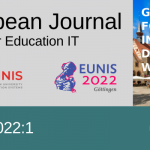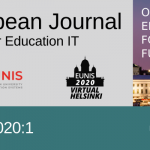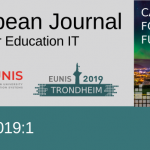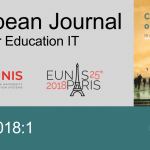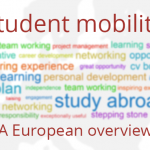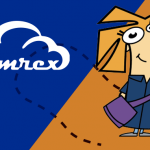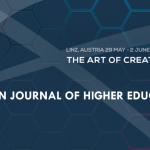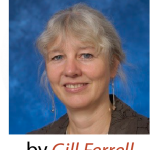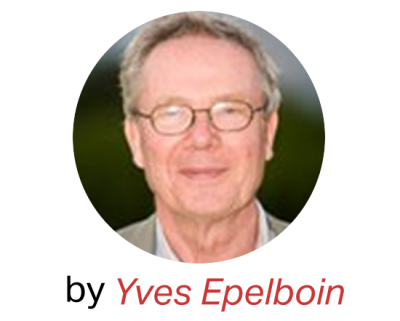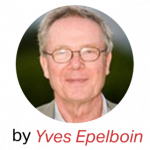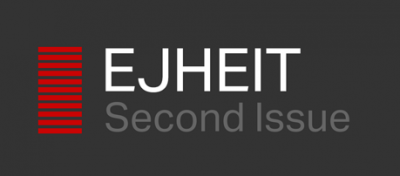EUNIS Journal of Higher Education IT – EJHEIT
This 2015/1 Issue of Eunis Journal of Higher Education IT is the second issue that publishes full papers from the EUNIS congress.
ISSN 2409-1340
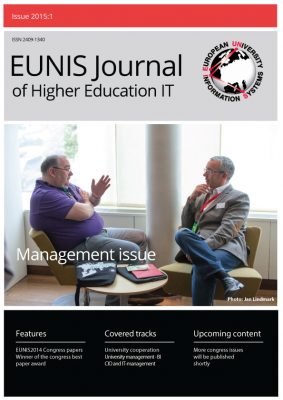
This second congress special Issue of the Eunis Journal of Higher Education IT focuses on papers coming from the management and cooperation tracks University Cooperation, University Management – Business Intelligence and IT-Management and the Chief Information Officer of the annual congress.
The tracks contained several good presentations and papers. The management aspects of IT at the University is something that has been a recurrent topic at congresses from the very beginning. In total 11 papers were presented within these tracks.
de Haan and Zomeren’s paper “Maximizing benefits of cloud computing by Collaboration”, available in the “CIO and IT Management” track section of this Issue, was awarded “Best Paper” by the Congress Organisers.
University Cooperation
PEPPI CONSORTIUM
Tuomas Orama, Mika Lavikainen, Jaakko Rannila
Abstract
PEPPI CONSORTIUM
Tuomas Orama (tuomas.orama@metropolia.fi), Mika Lavikainen, (mika.lavikainen@metropolia.fi), Jaakko Rannila (jaakko.rannila@metropolia.fi)
This paper explains how and why Metropolia University of applied sciences and Tampere University of applied sciences extended their collaboration from Peppi project to a national consortium. The project itself followed open source principles from the beginning so it was a natural continuation to share the results with other higher education institutes as well as open the door for new vendors. In the paper we describe what kind of challenges developing information systems have nationally and why collaboration and interoperability are so important in information system development.
During the consortium process we encountered some challenges due to earlier decisions that were made. Initially we didn’t have any idea that we would extend the project to a consortium. These challenges are explained in the paper as well as the solutions that we ended up with. The consortium model that we use is new in Finland there are still lessons to be learned. Currently, the consortium is up and running and the future looks bright.
University Management – BI
STUDENT – CLASS ASSIGNMENT OPTIMIZATION – USING SIMULATED ANNEALING
Krzysztof Ciebiera, Marcin Mucha
Abstract
STUDENT – CLASS ASSIGNMENT OPTIMIZATION – USING SIMULATED ANNEALING
Krzysztof Ciebiera (ciebie@mimuw.edu.pl), Marcin Mucha (mucha@mimuw.edu.pl)
The University Study-Oriented System (USOS) is an integrated student management information system for handling student affairs at Polish universities. Its development and deployment is coordinated and supported financially by the consortium of Polish higher education institutions.
Course registration is one of the most important functions of the system. Timetabling problem is broadly studied subject leading to many theoretical and practical results [2, 5]. Part of the
registration problem is an assignment of students to classes after schedule has been published and students have been registered to courses. We have experimented with different strategies like “first in first served” or “greedy assignment method”’ however they seem to be either unfair or results are not satisfactory. Too many students had conflicts (two or more classes at the same time) or were unable to register to any class.
We have created computer program based on simulated annealing local search method, that allowed us to reduce number of students having conflicts by 20%. First students define their preferences using self-service web based system, then the registration system is taken to read-only mode and assignments are generated using our engine (SA-RDG), and at the end of a process, results are imported into web system where they are available for students.
In this paper we describe algorithm details, technical solution method and we present empirical results of the system performance at Mathematics, Computer Science and Mechanics Department of University of Warsaw in years 2010-2013. SA-RDG is default registration method for USOS installed in 40 higher education institutions in Poland.
Research was supported by the ERC StG project PAAl no. 259515.
EDUCATIONAL DATA MINING: PRELIMINARY RESULTS AT UNIVERSITY OF PORTO
Pedro Strecht, João Moreira and Carlos Soares
Abstract
EDUCATIONAL DATA MINING: PRELIMINARY RESULTS AT UNIVERSITY OF PORTO
Pedro Strecht, João Moreira and Carlos Soares
Predicting the success or failure of a student in a course or a program is a problem that has recently been addressed using data mining techniques.
However, the literature shows that there is still no consensus on what is the best set of variables that may lead t o accurate models.
Moreover, the problem is quite complex and appears to be very dependent on the data set used
(Kabakchieva, 2013). It is related to student attrition, a research area of Educational Data Mining.
This paper presents the results of preliminary experiments in this research area at the University of Porto. The experiments were carried out using automated approaches on administrative data. Although the number of courses is small, initial conclusions were drawn.
I HAVE GIVEN A NAME TO MY PAIN, AND IT IS “ETL”
Bob Strunz
Abstract
Bob Strunz
The first stage in the Business Intelligence data flow is the ETL stage, Extract, Transform and Load. This is where data is shipped from the data source into the target data warehouse. This paper reports preliminary results of an exercise that was intended to assess the potential challenges that might be expected should the institution make the decision to implement an enterprise data-warehouse (EDW).
The results of the experiment were interesting (though not always encouraging) however the process proved to be very worthwhile in demonstrating to senior management some of the more complex aspects of data-storage and management at the institution and also the potential uses that data could be put-to.
The use of Data Profiling on the source database exposed some underlying structural and administrative challenges that will need to be addressed in advance of a full BI implementation. The implementation of a prototype data-warehouse using Microsoft BI technology demonstrated clearly that the cost of BI need not be a prohibitive factor in an implementation of this type, provided that the institution has the appropriate skills-sets at its disposal. The exercise of going through the implementation, despite the fact that it was a “whistle-stop” process gave the author a very comprehensive insight into the challenges to be expected and provided the executive of the institution with a range of issues to consider in advance of any implementation decision.
IT-Management and the CIO
ONE-STOP UNIVERSITY ADMINISTRATION: AN INFORMATION ARCHITECTURE FOR HIGER EDUCATION
Josef Kolbitsch
Abstract
ONE-STOP UNIVERSITY ADMINISTRATION: AN INFORMATION ARCHITECTURE FOR HIGER EDUCATION
Josef Kolbitsch
Higher education institutions have implemented numerous administrative processes for managing the student lifecycle and research activities. In many cases, the corresponding services units (operating departments) including the HR department, finance department, and student administration design and implement these processes. The documentation of the processes, if it exists, can be found on the web-sites of individual departments.
Consequently, staff and students have to know which service units offer which administrative processes and services. This results in degraded efficiency of the administrative processes. Many hours are lost because staff and students do not know that services exist, they cannot find the right forms, and do not know how to fill them out.
At Graz University of Technology, a new information architecture with a “one-stop university administration” was designed: Students and staff should find all required information, get access to services, and initiate administrative processes in a single information system. This information architecture was implemented as “TU4U”, the university’s intranet and service portal.
EVALUATION OF DIGITAL ASSESSMENT
Kurt Gammelgaard Nielsen, Lise Petersen, Birgitta Wallstedt, Poul Basse, Pernille Stenkil Hansen, Søren Steen Hansen and Dorthe Majlund Sørensen
Abstract
EVALUATION OF DIGITAL ASSESSMENT
Kurt Gammelgaard Nielsen, Lise Petersen, Birgitta Wallstedt, Poul Basse, Pernille Stenkil Hansen, Søren Steen Hansen and Dorthe Majlund Sørensen
University of Southern Denmark (SDU) decided to start a project to implement digital assessment in May 2010. By the exam term of January 2014 the formal goal of the implementation project – all written exams should be digital – was reached by all 5 faculties and 5 campuses. Paper is no longer used at exams, and the students handed in a total of 75.000 digital assignments in 2013 (SDU Assignment Stats, 2014).
In this paper we will evaluate the project according to generally accepted criteria for quality of assessment:
Validity – the assessment measures the whole testable domain (knowledge, skills, competences) that it is supposed to measure.
Reliability – the assessment is reliable – i.e. there is a consistent
discrimination between good and poor performance.
Acceptability – the assessment is widely accepted as being ‘good’
by students and faculty.
Feasibility – the resources, which are required to conduct the
assessment, are available
According to these criteria the implementation of digital assessment at SDU has been partially successful:
• A conscious approach to assessment and ongoing discussions has brought us a long way in increasing validity and reliability.
• The acceptability of digital assessment is high among students.
• The resources have been present, and the goal of feasibility of digital assessment has been partly achieved, due to automation of workflow and due to students bringing their own computer (BYOD).
The formal goals of implementing digital assessment at Danish Universities are described in the Danish eGovernment strategy (2011). The overall goals of digitization are to strengthen the teaching and increase operational efficiency. By using our set of four criteria in evaluating digital assessment we attempt to impose more aspects to the evaluation, and to address the quality aspect in a more concrete and direct way.
THINGS TAKE TIME – ESTABLISHING USABILITY WORK IN A UNIVERSITY CONTEXT
Åsa Cajander, Gerolf Nauwerck and Thomas Lind
Abstract
THINGS TAKE TIME – ESTABLISHING USABILITY WORK IN A UNIVERSITY CONTEXT
Åsa Cajander, Gerolf Nauwerck and Thomas Lind
This short paper presents a two year long project with the goal to establish usability work in a university context. The project was a collaborative project where members from the planning division worked together with action researchers in order to reach the project goals. During the first year the project members educated almost 200 of the IT professionals working at the university, and organised seminars and workshops. The second year the project did two studies connected to the work environment and usability issues of the people working with economy which were well received within the organisation. To conclude one can say that the project was successful, and that the collaboration within the project worked well despite the fact that it is difficult to measure organisational changes of this nature. Usability work is now an integrated part of the development plans at the university, and usability work will be catered for by a the establishment of a knowledge center to enable continuous development in this field. However, one can conclude that a sustainable work environment requires sustainable change process regarding usability. There are surely no quick fixes, and things take time.
WINNER OF THE CONGRESS BEST PAPER AWARD
MAXIMIZING BENEFITS OF CLOUD COMPUTING BY COLLABORATION
Wouter de Haan and Bert van Zomeren
Abstract
MAXIMIZING BENEFITS OF CLOUD COMPUTING BY COLLABORATION
Wouter de Haan and Bert van Zomeren
SURF is the organisation for collaboration in Higher Education in the Netherlands. Its mission is to enhance the quality of education and research through innovation in IT. Cloud computing is growing fast and offers many opportunities to increase quality and flexibility of IT services, and to decrease costs. Three years ago SURF started a program to stimulate the use of cloud computing by the Dutch HE institutions. This program is driven by the central idea that the benefits of cloud computing can and must be maximized by collaboration. SURF produced a strategic document which contains the most important common ambitions to be realized in the next five to ten years. International collaboration, for instance within Europe, could deliver a positive contribution
ADOPTING MICROSOFT LYNC AT UMEÅ UNIVERSITY – A MIGRATION FROM LEGACY PBX TO LYNC
Mattias Holmlund and Arne Vedefors
Abstract
ADOPTING MICROSOFT LYNC AT UMEÅ UNIVERSITY – A MIGRATION FROM LEGACY PBX TO LYNC
Mattias Holmlund and Arne Vedefors
In 2013 Umeå university migrated from a traditional PBX (PBX is a system that connects telephone extensions of a company to outside public telephone network as well as to mobile networks) to Microsoft Lync 2013 – an enterprise-ready unified communications platform that besides voice also supports presence, instant messaging, video calls and online conference meeting.
This presentation is about:
– The recommendations and the fall pits around a migration to Lync
– The experience acquired from what the users encountered when they adopted the new way of using their computers.
– The importance of a thorough analysis and plan for shaping your infrastructure and set-up to follow best practice prior the implementation itself.
The main success factors of this project was, thorough hard ware planning, follow best practice, train the end user and let the product adopt within the organization, follow up what the common user lacks and finally plan how you can precede the problems that comes tomorrow.
THE ID POINT SERVICE MODEL
Maria Kalske and Mika Kivilompolo
Abstract
THE ID POINT SERVICE MODEL
Maria Kalske and Mika Kivilompolo
In the ID Point service model the identification of the user and the delivery of the service are separated from each other. This allows to build centralize services for the cases that would traditionally require visiting at local service point.
INFORMATION TECHNOLOGY – IN TRANSFORMATION: ORGANISATIONAL STRUCTURE IMPLICATIONS?
Noel Wilson
Abstract
INFORMATION TECHNOLOGY – IN TRANSFORMATION: ORGANISATIONAL STRUCTURE IMPLICATIONS?
Noel Wilson
The pace of technological changes and the associated changes to higher education, in general, are factors that may influence our IT department’s organisational structures. The department needs to be aligned to the institution’s mission, vision and goals yet have the capability to proactively change in response to new technologies, new customer-centric requirements and to the prevailing economic climate. Do we have the appropriate governance structures; do we have the expertise and capacity we need; are there opportunities to divest in-house interests in some technologies and reinvest these in alternative sourcing models? These are some of the issues confronting higher education IT departments. Effectiveness of overall IT investment, whether in technologies or in human resources is of paramount importance to both senior management and to users of central IT departments. The paper outlines some implications associated with the types of changes referred to, seeking to identify how to capability, framework alignments(e.g. ISO, ITIL) and functional components may be achieved. It also touches upon the cultural implications associated with change and change management.

